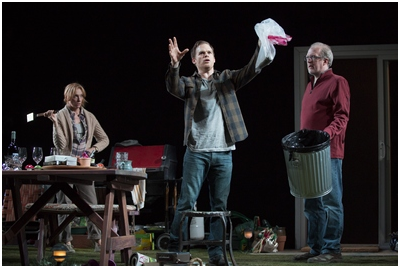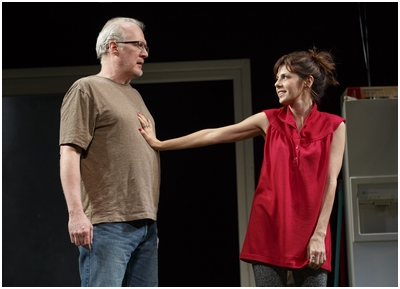The Realistic Joneses

Toni Collette, Michael C. Hall and Tracy Letts
in a scene from The Realistic Joneses
(Photo credit: Joan Marcus)
The Realistic Joneses, Will Eno’s first Broadway play, written in his own inimitable style, will have as many advocates as detractors. The quartet of stars comprised of Toni Collette, Michael C. Hall, Tracy Letts and Marisa Tomei do their best to make you think something is happening, but in this story of the interaction between two neighboring couples with same last name, you could measure the progress in teaspoons. Sam Gold, fast becoming the director of choice for cutting edge American playwrights (Annie Baker’s The Flick which just won the 2014 Pulitzer Prize, Theresa Rebeck’s Seminar, Lisa Kron and Jeanine Tesori’s Fun Home at the Public, etc.), keeps things moving along. However, if you have seen Eno’s The Open House which just completed its run at the Signature Center or Middletown seen at The Vineyard in 2010, you know that his characters almost never finish a thought or respond to what is said.
The play begins with husband and wife Jennifer and Bob Jones (Collette and Letts) spending a quiet evening in their backyard surrounded by pine trees in a small rural town. They appear to be in the middle of a low-key argument. We discover that he has a neurological degenerative disease and is trying to ignore it while Jennifer, his caregiver, resents that he won’t talk about it. They are suddenly interrupted by Pony and John Jones (Tomei and Hall) who have just rented the house next door, empty quite a while. The new neighbors have brought a bottle of wine but pointedly it is never opened in the course of the play. Pony is kind of scattered and misses the point of most things, while John has a wry sense of humor and challenges everyone’s semantics so that conversation becomes difficult. Apropos of nothing, John tells Bob, “We are not so different, you and me,” but Bob vehemently denies it. By the end of the play, Bob would probably agree that they are similar in many ways.
In a series of 11 more short scenes, the four meet in varying combinations, at the grocery store, in Pony and John’s kitchen, outside their houses, and again at Bob and Jennifer’s backyard. We discover that John is suffering from the same degenerative disease as Bob. This town has one of the world’s leading specialists which is the reason why both couples have moved here. While Jennifer is monitoring Bob’s progress and trying to put a good face on things, John has not told Pony – who does not like to deal with life’s unpleasantries – but she suspects something is seriously wrong. Both couples give off signals that their marriages are in trouble over how they are handling the medical situations. However, the play veers off into the metaphysical, giving almost every conversation a possibly greater significance. By the end of the play, the two couples who seemed so different at the beginning have reached a rapprochement as they sit comfortable with each other at Jennifer and Bob’s picnic table, just like at the beginning. One possibility is that in their dealings with adversity, both couples have found their common humanity, but in an Eno play you can never be sure of anything.

Tracy Letts and Marisa Tomei
in a scene from The Realistic Joneses
(Photo credit: Joan Marcus)
Eno’s dialogue is unlike anyone else’s. On the obvious level, the talk is both mundane and banal, like most casual encounters. Besides the non-sequitors which the characters use to change the subject, their remarks are often potentially comic (“I practically invented sitting down”) but do not achieve laughs. Although both couples are in their 40’s, Pony never seems to understand things that a person her age usually does from single words like congenital to common expressions like “say no more” to “where little acorns become big acorns,” and makes remarks that suggest a lack of sagacity (“I feel like I should go to med school or get my hair cut or something.”) John misuses the language, whether intentional or not is never made clear, makes pronouncements and then takes them back immediately (“Sometimes, I forget stuff. On the other hand, sometimes I remember stuff.”) When he misunderstands – or pretends to misunderstand (“still waters,” “the world’s oldest profession,” “the greatest story ever told,” etc.,) he appears to be insulted to have it brought to his attention. Bob’s laconic responses are usually misunderstood for their very brevity. And Jennifer plays peacemaker and adapts to the others’ habits. But nothing is quite what it appears to be.
The cast give fine performances in roles unlike those we have seen them in before. However, they cannot make the play seem any less static than it appears to be on the surface, or even give us the feeling that much is happening. Academy Award winner Tomei is amusing as Pony who never seems to be aware of what she doesn’t know. As her husband John, popular television star Michael C. Hall (Dexter and Six Feet Under) has a wry sense of humor as a man dealing with an illness he does not yet fully understand. Letts, Pulitzer Prize-winning playwright of August: Osage County and 2013 Tony Award and Drama Desk Best Actor winner for his performance as George in Who’s Afraid of
Virginia Woolf?) is both sinister and intense in his very silences. Australian film star, Collette, last seen on Broadway in the 2000 musical The Wild Party, has the least defined role as Bob’s understanding wife Jennifer and fleshes it out with her compassionate cheerfulness.
Surrounded by tall pine trees on both sides of the stage, David Zinn’s setting economically puts three locales side by side – Bob and Jennifer’s backyard, the sliding glass doors which stand in for the back of both homes, and Pony and John’s kitchen with its unpacked boxes. The costumes by Kaye Voyce are so realistic as to appear that the actors brought the items from their own wardrobes. From the first evening scene, to the encounter in the grocery store, through the starry night scene, to the early evening finale, Mark Barton’s lighting is appropriately atmospheric. However, the many blackouts between the 11 short scenes may give some theatergoers’ vision a problem. Leon Rothenberg’s sound effects are notable for such things as evening crickets chirping, an owl hooting, church bells ringing, and the sound of fireworks which add colors to the nondescript setting.
The Realistic Joneses introduces a new American playwright to Broadway, one with a unique voice all his own. Whether main stem audiences will understand Will Eno’s cadences is another question. Toni Collette, Michael C. Hall, Tracy Letts and Marisa Tomei give the play a fine patina of urbanity. This, however, is not a play for all theatergoers. With its slightly mocking title (as these are anything but realistic Joneses), it is for those who want to be challenged and who want something new.
The Realistic Joneses (through July 6, 2014)
Lyceum Theatre, 149 W. 45th Street, in Manhattan
For tickets, call 212-239-2600 or http://www.therealisticjoneses.com
Running time: one hour and 40 minutes with no intermission

Leave a comment